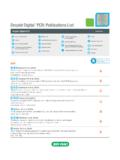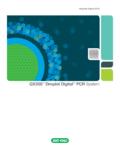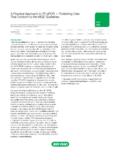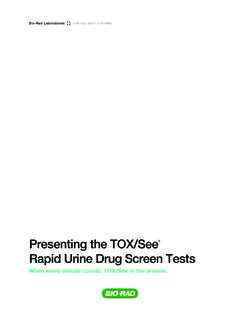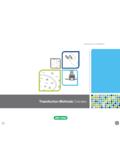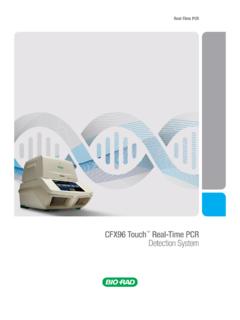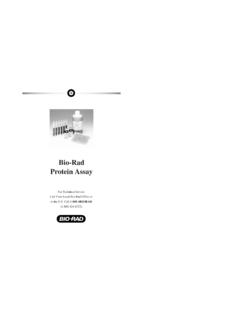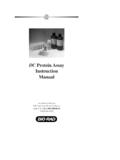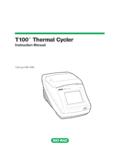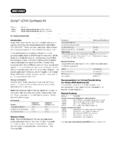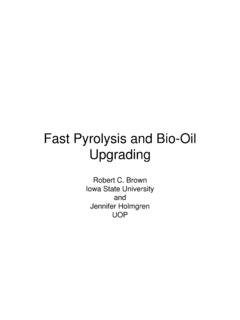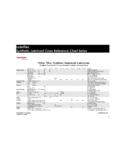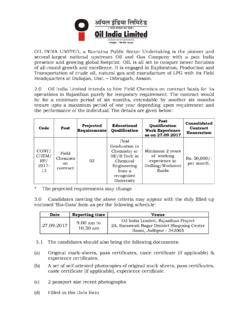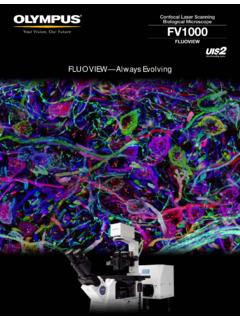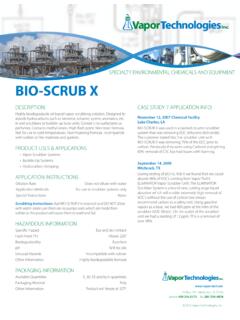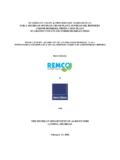Transcription of ddPCR™ Mutation Detection Assays, Validated - …
1 DdPCR Mutation Detection Assays, Validated Catalog # Description 10031246 ddPCR Mutation Detection assay , Validated (FAM), 200 x 20 l reactions 10031247 ddPCR Mutation Detection assay , Validated (FAM), 1,000 x 20 l reactions 10031248 ddPCR Mutation Detection assay , Validated (FAM), 2,500 x 20 l reactions 10031249 ddPCR Mutation Detection assay , Validated (HEX), 200 x 20 l reactions 10031250 ddPCR Mutation Detection assay , Validated (HEX), 1,000 x 20 l reactions 10031251 ddPCR Mutation Detection assay , Validated (HEX), 2,500 x 20 l reactions For research purposes only. Description ddPCR Mutation Detection Assays are expertly designed specifically for Droplet Digital PCR (ddPCR) using proprietary computational algorithms.
2 These assays have been wet-lab Validated by Bio-Rad. Validation data are available for review and download from the assay page on the Bio-Rad website. Reference assays with the complementary dye can be purchased separately. Ordering Information The ddPCR assays can be ordered online at Storage and Stability The ddPCR assays are stable for 12 months when stored at 4 C protected from light. The 20x assay mix can be kept at 20 C for long-term storage. Kit Contents The ddPCR Mutation Detection assay is a 20x concentrated, ready-to-use primer-probe mix optimized for use with ddPCR Supermix for Probes (No dUTP). Each kit comes with 200, 1,000, or 2,500 l of the 20x assay mix (9 M primers and 5 M each probe), sufficient for 200, 1,000, or 2,500 x 20 l reactions, respectively.
3 Required Reagents and Equipment ddPCR Supermix for Probes (No dUTP) (catalog #1863023, 1863024, 1863025) QX100 or QX200 Droplet Generator (catalog #1863002 or 1864002, respectively) or Automated Droplet Generator (catalog #1864101) QX100 or QX200 Droplet Reader (catalog #1863003 or 1864003, respectively) C1000 Touch Thermal Cycler with 96 Deep Well Reaction Module (catalog #1851197) PX1 PCR Plate Sealer (catalog #1814000) Please refer to the QX100 or QX200 Instruction Manuals (#10026321 and 10026322 or 10031906 and 10031907, respectively) or the Automated Droplet Generator Instruction Manual (#10043138) for ordering information on consumables such as oils, cartridges, gaskets, plates, and seals.
4 Restriction Enzyme Digestion of Sample DNA DNA fragmentation by restriction digestion prior to droplet generation enables optimal accuracy by separating tandem gene copies, reducing sample viscosity, and improving template accessibility. Two strategies may be used to perform restriction digestion of DNA samples: digestion directly in the ddPCR reaction during setup (recommended) or conventional digestion prior to Droplet Digital PCR. Digestion Directly in ddPCR Reaction Efficient digestion of sample DNA can be achieved by direct addition of restriction enzyme to the ddPCR reaction 2 5 units of restriction enzyme per ddPCR reaction are recommended Dilute the restriction enzyme using the recommended diluent buffer according to the manufacturer s instructions, and then add 1 l to the ddPCR reaction according to the guidelines in Table 1 Reactions can be set up at room temperature.
5 No additional incubation time is required The addition of restriction enzyme buffers with high salt content can inhibit Droplet Digital PCR and should be avoided Digestion Prior to Droplet Digital PCR Restriction enzyme digestion can be carried out as a separate reaction before ddPCR reaction setup Use 10 20 units of restriction enzyme per microgram of genomic DNA Incubate the reaction for 1 hr at the temperature recommended for the restriction enzyme Heat inactivation is not required but can be considered if long-term storage is required; do not heat inactivate above 65 C DNA purification is not necessary after restriction digestion Use a minimum 10-fold dilution of the digest to reduce the salt content of the sample in Droplet Digital PCR Store digested DNA at 20 C or below ddPCRTM Mutation Detection Assays, Validated P 2015 Bio-Rad Laboratories, Inc.
6 10033487 Ver C Reaction Setup 1. Thaw all components to room temperature. Mix thoroughly by vortexing the tube to ensure homogeneity because a concentration gradient may form during 20 C storage. Centrifuge briefly to collect contents at the bottom of each tube and store protected from light. 2. Prepare samples at the desired concentration before setting up the reaction mix according to the guidelines in Table 1. If multiple samples are to be assayed using the same target and reference duplex, prepare a master reaction mix without sample template, dispense equal aliquots into the reaction tubes, and add the sample template to each reaction tube as the final step. 3. Prepare a negative control: at least one well containing only wild-type template at a concentration similar to the concentration of unknown samples.
7 4. Prepare a positive control: at least one well with a mix of 7 ng of mutant DNA in a background of 130 ng of wild-type DNA. Table 1. Preparation of the reaction mix. Component Volume per Reaction, l Final Concentration 2x ddPCR Supermix for Probes (No dUTP) 10 1x 20x target primers/probe (FAM or HEX) 1 1x** 20x reference primers/probe (HEX or FAM) 1 1x** Restriction enzyme, diluted* 1 2 5 U/reaction DNA sample or water Variable 50 fg 100 ng Total Volume 20** * This component should be replaced by water if digestion is performed prior to Droplet Digital PCR. ** For the Automated Droplet Generator, prepare 22 l per well. ** 450 nM primers/250 nM each probe. For most assays, up to 130 ng of DNA containing mutant DNA at >2% fractional abundance is expected to perform adequately.
8 Input may be lowered if cluster separation is not adequate. 5. Mix thoroughly by vortexing the tube. Centrifuge briefly to ensure that all components are at the bottom of the reaction tube. Allow reaction tubes to equilibrate at room temperature for about 3 min. 6. Once the reaction mixtures are ready, load 20 l of each reaction mix into a sample well of a DG8 Cartridge (catalog #1864008) followed by 70 l of Droplet Generation Oil for Probes (catalog #1863005) into the oil wells, according to the QX100 or QX200 Droplet Generator Instruction Manual (#10026322 or 10031907, respectively). For the Automated Droplet Generator, follow instructions in the Automated Droplet Generator Instruction Manual (#10043138).
9 Thermal Cycling Conditions 1. After droplet generation with the QX100 or QX200 Droplet Generator, carefully transfer droplets into a clean 96-well plate or remove the plate containing ddPCR droplets from the Automated Droplet Generator. Seal the plate with the PX1 PCR Plate Sealer. 2. Proceed to thermal cycling (see protocol in Table 2) and subsequent reading of droplets in the QX100 or QX200 Droplet Reader. Table 2. Cycling conditions for Bio-Rad s C1000 Touch Thermal Cycler.* Cycling Step Temperature, C Time Ramp Rate Number of Cycles Enzyme activation 95 10 min 2 C/sec 1 Denaturation 94 30 sec 40 Annealing/extension 55 1 min Enzyme deactivation 98 10 min 1 Hold (optional) 4 Infinite 1 C/sec 1 * Use a heated lid set to 105 C and set the sample volume to 40 l.
10 Data Acquisition and Analysis 1. After thermal cycling, place the sealed 96-well plate in the QX100 or QX200 Droplet Reader. 2. Open QuantaSoft Software to set up a new plate layout according to the experimental design. Refer to the QX100 or QX200 Droplet Reader and QuantaSoft Software Instruction Manual (catalog #10026321 or 10031906, respectively). 3. Under Setup, double click on a well in the plate layout to open the Well Editor dialog box. 4. Designate the sample name, experiment type, ddPCR Supermix for Probes (No dUTP) as the supermix type, target name(s), target type(s), and reference: Ch1 for FAM and Ch2 for HEX. 5. Select Apply to load the wells and, when finished, select OK. 6. Once the plate layout is complete, select Run to begin the droplet reading process.
